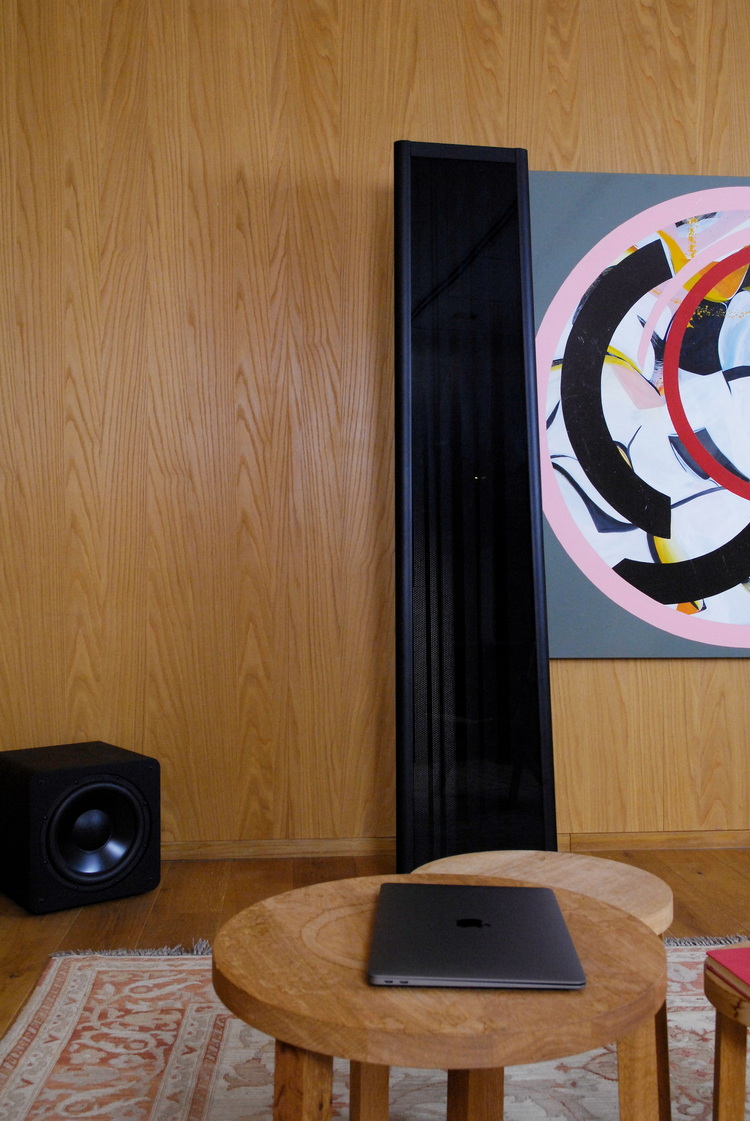Review: FINAL 15 –Final has launched a series of new electrostats. It is a revolutionary step and certainly not an evolutionary continuation of earlier generations of models. At its core, Final is an extremely innovative company that is continuously working to find solutions to the fundamental challenges that are inherent in the simple basic principle of an electrostatic. The new models actually distance themselves from what is on the market. Given the almost completely new technology, it is not unreasonable to speak of the electrostatic next level. Reason to listen to the current top model, being Model 15. Surprises await there. |
Final 15 audio
Electrostatic loudspeakers are a niche in the market. From a technical point of view, the electrostatic principle is simple, but there are quite a few complex challenges to build a properly functioning and reliable electrostatic. Few manufacturers can build electrostats with any success. There are good electrostats from Martin Logan, QUAD, Van Medevoort and Final. They have all found their own solutions to build these loudspeakers.
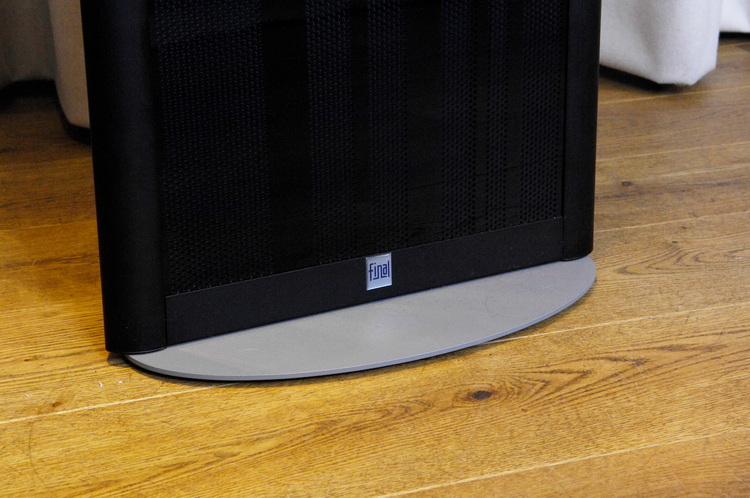
Final was founded in 1989 by Maarten and Michiel Smits. The gentlemen left the company in 2004. Final started again recently, again led by Maarten Smits.
Fundamental challenges in developing electrostats were the limited frequency range, higher distortion, the decay of the diaphragm under the influence of light and pollution, and the effect that a good stereo image is only available at a narrowly defined listening position. The very first electrostats had a stator and a membrane. Then the distance between the two always varies and that causes distortion. This was solved by placing the membrane between two stators. The membrane then acquires a fixed charge due to the fixed high voltage between the stators and the membrane. The stators mutually have a voltage that follows the sound signal. The force on the membrane in this configuration is proportional to the alternating charge on the stators and the fixed charge on the membrane. This removes the distortion. Later on, the deformation decreased even further due to the availability of thinner foils. That membrane has a conductive layer. This is usually applied by hand and never has the same density per unit area. Because stators are in many cases made of steel and a steel plate is never really flat, the distance from the stator to the membrane is not constant. That does not contribute to a balanced sound with low distortion.
Ideal speaker?
One question is why a consumer would want an electrostatic. This often leads to endless disputes, especially on the internet, about the pros and cons of all kinds of loudspeakers. That is basically a nonsense discussion. The ideal loudspeaker does not exist and the different loudspeaker types were initially developed within a professional market based on very specific requirements regarding an application area. Contemporary discussions about this, within a previously hardly present amateurish and hobby-like context of use, really lack that important essence.
The horn loudspeaker was created at a time when large spaces, such as the 1930s cinema halls, had to be filled with sound, while amplifiers at that time hardly delivered more power than 20-50 watts. Line arrays are a solution for realizing enormous sound pressures, where the decrease in sound per unit length is less than with point sources. The sound is also easy to direct. Ribbon element horns, ribbed drivers, and magnetostats answered the need for speakers that sound fast, neutral and detailed. Today’s ribbed drivers can deliver a sound pressure of 140dB, so they are also used in PA systems. The question then is why, after the emergence of the ‘hi-fi market’ in the mid-1960s, the cone loudspeaker became dominant. Not because these were so good at the time, with an exception for professional systems from JB Lansing, among others, but the cone loudspeaker was simply cheap and without too many technical problems. With the bass reflex trick, it was also possible to remove low from a small box.
As to the professional reasons behind the origin of the electrostatic, the literature remains vague. The principle of this loudspeaker was discovered and patented by Arthur Janszen in 1953. However, the QUAD electrostat is actually based on an earlier General Electric patent from 1934. Perhaps it is reasonable to assume that QUAD realized the first commercial application of the electrostat. The literature does indicate that there were at least two specific target groups and therefore reasons for the development. Namely the consumer who is mainly a music lover and the broadcasters and studios that wanted to use the QUAD as a professional monitor (BBC and Philips). The advantages of the electrostatic for these target groups, which were an important attraction point early in history, were and are the neutrality, the speed, the spatiality, the very low distortion and the lack of phase problems as a result of the lack of filter technical issues in the transfer areas between drivers. An electrostatic membrane has a low mass. So music can sound fast and detailed.
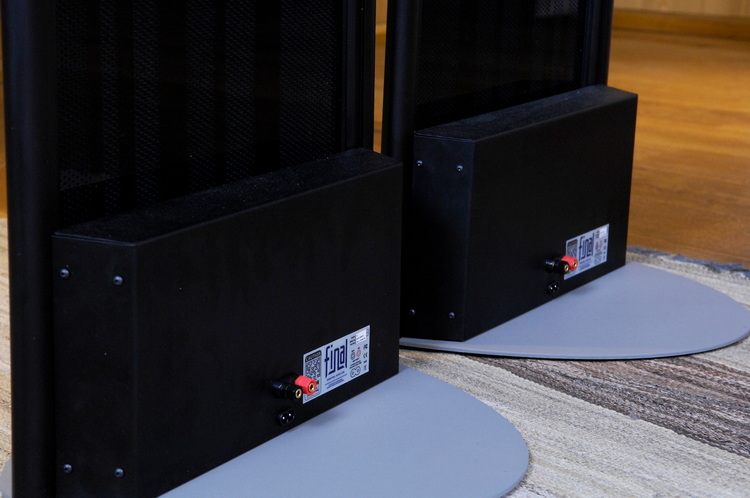
Innovation in FINAL 15
A constant element at Final is the innovative ability to find solutions ‘out of the box’. There is hardly any other manufacturer of electrostats that has introduced fundamentally new solutions to the aforementioned technical issues. While the stators used to be made of metal, Final uses PMMA plastic stators. This material is extremely flat, so the distance to the membrane is constant everywhere. In addition, the distance between the stator and the membrane can also be reduced. A conductive layer is applied to the stator, but it can have different patterns. For example, different in width for the high, medium and low display. The sound-radiating surface then becomes narrower in width. This removes the effect that an electrostatic can only produce a good image at a single fixed listening position. With the new Final electrostats there is a ‘normal’ stereo image, which remains virtually stable regardless of the listening position. The conductive layer on the stator is applied using an inject print technology developed by Final. This gives an extremely uniform density of the applied material. Due to the flatness of PMMA and the uniformity of the conductive layer, the distortion is further reduced. PMMA can be supplied in any conceivable color and can even be completely transparent. Due to the flatness of PMMA and the uniformity of the conductive layer, the distortion is further reduced. PMMA can be supplied in any conceivable color and can even be completely transparent. Due to the flatness of PMMA and the uniformity of the conductive layer, the distortion is further reduced. PMMA can be supplied in any conceivable color and can even be completely transparent.
During demonstrations, Final is happy to show a bright blue version of the Model 15 electrostat. Together with the beautifully chromed frame, this is a huge eye-catcher. The PMMA material has a modern, trendy and extremely luxurious look. It is also resistant to chemical decay. Metal stators can rust. PMMA is also resonance free. In principle, a metal stator can resonate with the music. Since PMMA is not conductive, the user cannot receive an electric shock. Electrostats work with very high voltages. If a metal stator has a weak spot in the insulating paint layer, the user may get a sensitive tap. Final has also been innovating in the field of the membrane. Electrostats used to have a Mylar membrane with a graphite coating. Final applies Teonex with a coating of Indium Tin Oxide. This is an aviation material, it is non-aging and stable in extreme conditions. Final has a very advanced technique for applying this conductor to the membrane. During this process, the resistance per surface unit can be determined. The membrane can thus be adapted to specific impedance requirements. The binder for this material blocks UV radiation. Testing at Final shows that this material does not show any kind of degradation as of 2012. It is therefore no longer necessary to have a membrane replaced every six years. During this process, the resistance per surface unit can be determined. The membrane can thus be adapted to specific impedance requirements. The binder for this material blocks UV radiation. Testing at Final shows that this material does not show any kind of degradation as of 2012. It is therefore no longer necessary to have a membrane replaced every six years. During this process, the resistance per surface unit can be determined. The membrane can thus be adapted to specific impedance requirements. The binder for this material blocks UV radiation. Tests at Final show that this material does not show any kind of degradation as of 2012. It is therefore no longer necessary to have a membrane replaced every six years.
Final Model 15

The Model 15 is for many fans of this principle and for the undersigned the ultimate pièce de résistance. An almost full range electrostatic with -3dB points at 45Hz and 23,000Hz. The height is 203cm. The model is tapered and the dimensions of the panel give a bottom width of 36.6cm and 33cm at the top. Including frame, the base width is 43 cm. With 18 kg, this speaker is very manageable. The frame is therefore made of aluminum. The tubes are slightly oval and not round. That gives a modern look. In the standard version, the frame is black and that also applies to the stators. A Model 15 stands on an aluminum-colored base in the form of a flat plate. The plate has a depth of 40cm and is 43cm wide. The electrostatic tilts slightly backwards. There is a connection for direct mains power. That does not go through an adapter. Two terminals (+ and -) connect the panel to an amplifier via a speaker cable. Given the very high level of finish of these panels, the loudspeaker terminals require replacement by more chic ones. Final advises to use amplifiers that can develop a power of 30 to 200 watts. With an efficiency of 88dB, this Final can also be controlled with low-power (tube) amplifiers.
Final claims that the new panels are virtually maintenance-free due to the use of sustainable materials. As a result, the electrostatic has a considerably longer life. These panels are also energy efficient. If the music signal is lost, the high voltage switches off after a short time. As soon as a signal is supplied again, the voltage switches on and the loudspeaker is immediately ready for use.
Performance of FINAL 15
The former Final 1.4 has been part of a group of reference loudspeakers in one of the listening rooms and especially in the studio for about ten years. In those years it was amplifiers such as the Jadis 200 and solid state electronics from Viola Labs (aka Cello) that delivered impressive performances. Those were examples of ideal combinations. The layer that such a large electrostatic provides is of very high quality. Like the 1.4, the Model 15 can present an impressive low. This became clear when Fantasia and Fugue was played in G minor BWV 542, performed by Michael Murray. Nevertheless, Final indicated that combinations of Model 15 with subwoofers are being looked into. The basic qualities of this large panel are strong. If, for example, an octave comes down, there is an even more impressive system. That is particularly suitable for music friends who partly find their environment between 16 and 30Hz.
Electrostats, and in particular Model 15, are not marketing-technically raised loudspeakers that are built for effect and intended to draw the visitor’s attention in the ‘wall of terror’, being the wall of loudspeakers at many hi-fi stores. Electrostats have intrinsic qualities and present the music in a way that can often be very realistic. Realism does not only depend on the speakers, but also on the electronics and recording. Before the Model 15 can be properly listened to, some training time is required. The set arrived here directly from the production line. During playback, changes are mainly noticeable in the low and middle reproduction. Ultimately, the whole system comes into balance and then reaches a spectacular performance level.
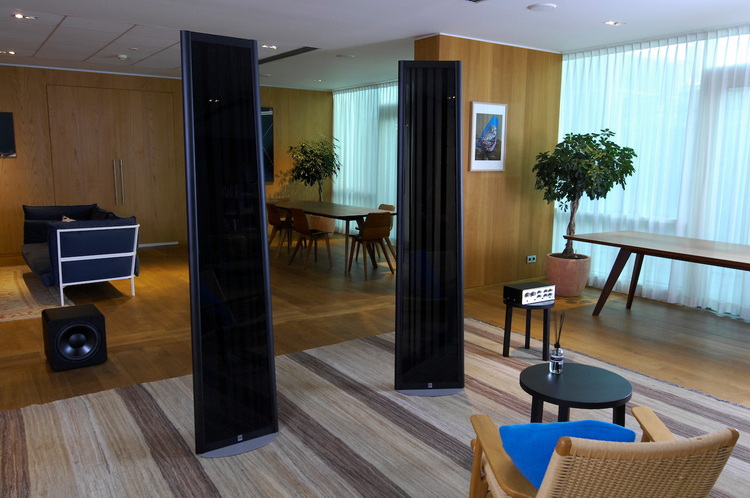
What stands out with the Model 15 is the phenomenal stage display. It is identical to that of high-quality dynamic systems. Depending on the recording, music can be heard far beyond both speakers. The reproduction is precise and has a very good focus. The stage remains very stable from almost any listening position. There is width and depth. The Model 15 sounds completely neutral. Neutral rendering is different from ‘cold and cool’. If heat is present in a recording, it is communicated excellently. This neutrality means that it takes some preparation to find a good match with electronics and cables. Any deviation from a neutral sound, caused by electronics that sound sharp, a recording that is no good or fancy designed cables, that lift it up high or just sound mean because the architecture is not good, cause immediately noticeable deviations. The Model 15 is merciless in this regard. If something is really good, you will hear it. However, every flaw in the system or the recording is also perceptible. The Final Model 15, for example, performs gloriously with the Purify Natural Stroke amps.
The cables used during the review have been developed here from engineering materials that you will not easily encounter in the consumer cable market. In principle, such a cable does nothing at all. Only let the sound through without adding or leaving anything out and that is exactly the intention. That does not mean that there are no cables on the consumer cable market that can also fit perfectly into a system around this Final Model 15. Sometimes it takes a while. To judge the influence of (analog) cables, try some baroque work. The strings often sound spicy there. However, with a good recording never harsh or mean. The Model 15 can reproduce this music perfectly. However, the combination with cables and electronics really requires attention. The Model 15 is a speaker on which you can play any kind of music.
The Model 15 can also handle large orchestral work, organ concerts and modern dance music. The Model 15 can perform absolutely strong and powerful in the low end. But the added value of an electrostatic is mainly in the quality of that bass reproduction. Anyone looking for a subsonic contribution, whereby physical objects in the listening room can be thrown around by the air movement of the system, has a somewhat too ambitious expectation pattern with electrostats. But, apart from being suitable for most music, this Model 15 reproduces the middle area very nicely. Voices benefit from this, but also wind instruments and the cello. Much has already been written about Todos Los Fuegos El Fuego by composer Maxim Shalygin (trptk 0050). The longer you listen, the more fascinating this work is. Listening toDeath of a Mosasaurus , this contemporary work induces numerous questions and thoughts. What exactly do you do to convert a story into sounds? Which sounds do you choose for atmospheres and story twists? What is the function of the selected melody? How is the relationship between story and music? Can you reconstruct a storyline on an emotional and instinctive level by listening to the music? Thoughts that occupy you for a long time. The Model 15 plays the sounds of the saxophones perfectly and keeps all those instruments neatly separated. This work is a huge challenge for an audio system.
Speaking of voices, the voice of Johannette Zomer has of course been entrusted to this great Final. Just listen to the Aria from BWV21 from the Channel Classics edition (ccs 39917). With regard to voices and bass reproduction, Céline Dion ‘s eponymous title track Encore un Soir is spectacular. A showpiece that shows what the Model 15 is capable of. Matters such as dynamics, copper tone, a great sounding grand piano, growling bass and sublime dynamics come together on Brother Veal of the Wynton Marsalis Septet (Blue Interlude). Belonging to the best sounding ceedee’s you can have. The system also convinces with orchestral work. The power and warmth from Anna Federova’s masterly reading of Rachmaninoff’s Piano Concerto No. 1are beautifully and atmospheric in the spotlight. It goes without saying that such an electrostatic sound is fast and detailed. It’s the speed and dynamics that make speaker systems sound realistic. The detailing is also excellent. It’s a realistic level of detailing. No hyped detail, because the tweeter is set 2dB too high or the electronics accentuate the high somewhere. Like all better audio systems, this configuration offers a lot of natural tranquility. Given that tranquility, freedom of distortion, dynamic capabilities and low distortion, it is wise to pay attention to the volume control. There is often a tendency to turn the sound too loud, while it is not perceived as such. A normal and standard monitoring level is around 75dB. When working in the studio, mixing and mastering, you need to maintain this level. If that deviates, then your mix is no longer correct. In addition, hearing damage is lurking.
Hi-res experiment
Because of the qualities of these electrostats, the Final Model 15 was then used to experiment with an issue that the forums are boiling over. Precisely because the 15, together with distinctive electronics, is a loudspeaker with which things can be judged very well. There are countless people who claim that they can hear the difference between a CD recording (16 / 44.1) and a hi-res format loud and clear. So the undersigned is not and many professional studio engineers also question this. Scientific evidence showed that 16 / 44.1 is enough to listen to everything, but this article also generated the necessary responses. A large-scale study set up a few years ago, based on 12,500 test cases, subsequently came with an interesting conclusion. Namely that there are actually very subtle differences perceptible, but that you have to be an extremely trained listener to be able to perceive them and you have to know exactly what to listen to. The research indicated that people who were intensively trained to hear those differences became more successful at doing so. In any case, that conclusion settles everyone who immediately shouts ‘yes, I hear immediately that this is a hi-res recording’ during shows and demos. But, what exactly are those things you should listen to? With that challenge, we listened to the Finals for a while and switched back and forth between program material with different resolutions. but that you have to be an extremely trained listener to perceive it and you have to know exactly what to listen to. The research indicated that people who were intensively trained to hear those differences became more successful at doing so. In any case, that conclusion settles everyone who immediately shouts during shows and demos ‘yes, I immediately hear that this is a hi-res recording’. But, what exactly are those things you should listen to? With that challenge, we listened to the Finals for a while and switched back and forth between program material with different resolutions. but that you have to be an extremely trained listener to perceive it and you have to know exactly what to listen to. The research indicated that people who were intensively trained to hear those differences became more successful at doing so. In any case, that conclusion settles everyone who immediately shouts ‘yes, I hear immediately that this is a hi-res recording’ during shows and demos. But, what exactly are those things you should listen to? With that challenge, we listened to the Finals for a while and switched back and forth between program material with different resolutions. In any case, that conclusion settles everyone who immediately shouts ‘yes, I hear immediately that this is a hi-res recording’ during shows and demos. But, what exactly are those things you should listen to? With that challenge, we listened to the Finals for a while and switched back and forth between program material with different resolutions. In any case, that conclusion settles everyone who immediately shouts during shows and demos ‘yes, I immediately hear that this is a hi-res recording’. But, what exactly are those things you should listen to? With that challenge, we listened to the Finals for a while and switched back and forth between program material with different resolutions.
It will of course be clear that, if there are differences, they can be caused by technology or that the production process for a hi-res or CD master is slightly different. A hi-res recording is made into a CD performance by means of a sampling converter. Then you may have the influence of a device and cables. However, the trick is to look for something ‘universal’. Is there really a universal feature that says something about the difference caused by a difference in sampling rate and / or bit width? So an unfinished search for that universal difference arose. It is not necessarily necessary to have a CD and a hi-res version of the same recording. You can just listen to CD music and hi-res recordings. Is there a universal difference out there that keeps recurring? The research is still underway here and it is too early to jump in the direction of conclusions. However, it is very difficult to spot such a universal difference. Yet the Finals show one or two aspects that keep coming back as being different between CD quality and hi-res. With a kind of temporary description about what those differences are, they tried to guess. Randomly choose a track from a list with a mix of CD and Hi-Res recordings. With a kind of temporary description about what those differences are, they tried to guess. Randomly choose a track from a list with a mix of CD and Hi-Res recordings. With a kind of temporary description about what those differences are, they tried to guess. Randomly choose a track from a list with a mix of CD and Hi-Res recordings.
As a result, guessing is correct rather than wrong, without immediately claiming that it is a significant statistical difference. This requires extremely strenuous and concentrated listening. Obviously all not really representative yet, but nice to play around with. The quality of the Finals is a challenge to these kinds of experiments. What becomes clear in any case is that it is not very easy to perceive the difference between CD quality and hi-res.
Epilogue
As with any loudspeaker principle, an electrostatic also has a recognizable signature. That is a thing of the past with this Model 15. Completely no longer recognizable as an electrostatic loudspeaker. But the specific advantages of this building principle have of course remained. A major attraction of larger speaker systems and thus this Model 15 is in the creation of a larger live stage and image. In a living room you therefore have the illusion of being present at a live performance. Loudspeakers such as these electrostats should preferably be placed freely in the room. However, that can get in the way of other life functions.
The beauty of the Model 15 is that you can quickly place it in the middle of the room while listening. When not in use, they can then stand flush against the wall. Due to the low weight, these systems can therefore be moved very quickly. That is less successful with a large dynamic system that often weighs 60+ kilos.
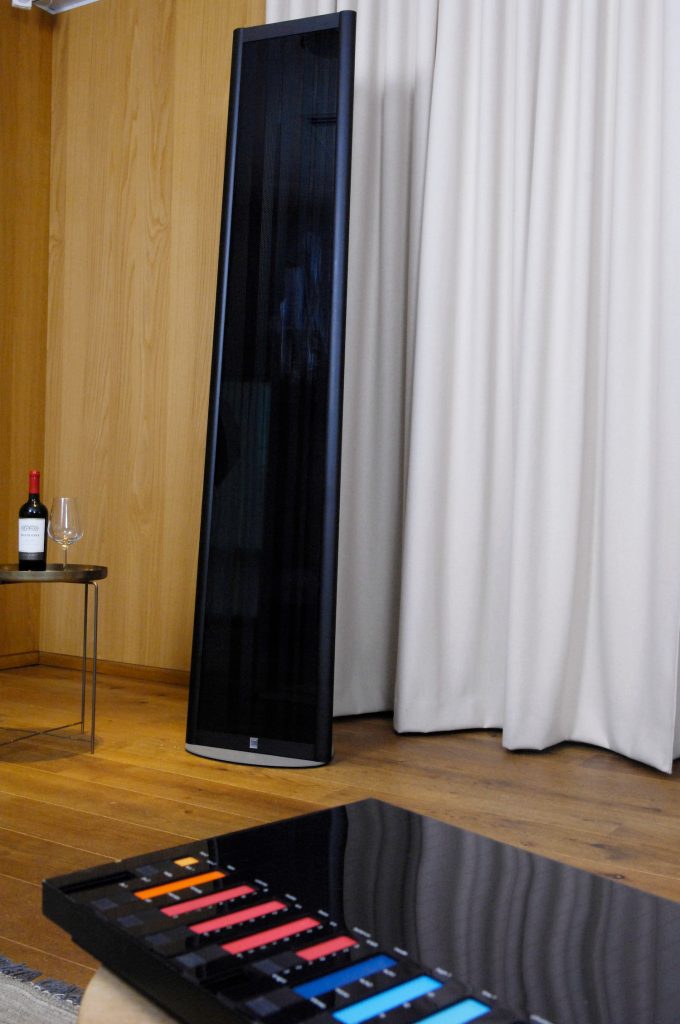
What really emerges is that this new Final is a huge step forward compared to almost all other electrostats. This is true innovation. The eletrostatic principle has thus been taken to a new level that has not yet been shown. The Final Model 15 puts on an unimaginable live stage, with uncanny focus, detailing and realism. Completely comparable to what the top of the dynamics systems does. That stage is immobile and does not change if the listening position changes. During the further anticipation, the bass became more and more level and in balance with the rest of the spectrum. The Final Model 15 is quite critical of the electronics due to its high resolution character. The right electronics don’t necessarily have to cost a fortune. But, if the match is right, then there is a system that plays with enormous transparency and phenomenal neutrality. But also a system that presents the atmosphere, warmth and glow from the recording in an impressive way.
The Model 15 can deliver unprecedented dynamics. Perhaps the physical experience and the pressure to be delivered is a fraction less than with the better dynamic systems. While the Model 15 can handle rough rock just fine, the die-hards in this genre might be a little happier with systems that live on the borderline of hi-fi and PA systems. But all other music is presented superbly. The undersigned has never been able to live with electrostats alone. It is a luxury position to be able to have a variety of speaker types on hand and as a reviewer it is inappropriate to have preferences. But the fact that these Finals weren’t put in the drawer right after the review was completed and that it remains fascinating to listen to every day is significant. So they have their own place in one of the listening rooms. It’s sort of a desert island system. They have a basic ‘rightness’. They are really next level electrostats. In any case, with Model 15, the consumer gets one of the most advanced electrostats of the moment. This electrostat offers a very attractive option for listening to music.
PLUS POINTS of FINAL 15
- Very good value for money
- Neutral, detailed, dynamic and spatial
- Very low distortion
- Suitable for all music
- Virtually full range
- Durable product with long life expectancy
- Beautiful design
- Live stage experience
- Low weight and flat so easy to move
- Revolutionary technology compared to the market standard
MINUSES of FINAL 15
- Asks for better speaker terminals
- Requires some concern with regard to electronics and cabling
- Preferably wants to be somewhat free in the room
- Is visually quite present
